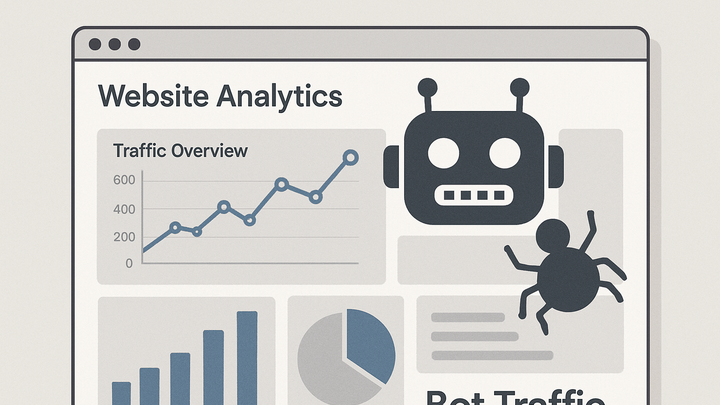Published on 2025-06-22T06:45:15Z
What is Bot Traffic? Examples and How to Mitigate It
Bot traffic refers to automated, non-human requests to a website or application endpoint, generated by software scripts, crawlers, or malicious bots.
While some bots, like search engine crawlers, serve useful purposes by indexing content, others can skew analytics metrics, commit click fraud, or scrape sensitive data.
In analytics platforms such as Google Analytics 4 (GA4), bot traffic can inflate pageviews, sessions, and conversion rates, leading to distorted insights.
PlainSignal, a cookie-free analytics solution, uses heuristic filters to automatically identify and exclude likely bot interactions from reports, ensuring cleaner data.
Detecting and filtering bot traffic involves combining built-in platform filters, custom code logic, and continuous monitoring to maintain high data quality and drive accurate business decisions.
Ignoring bot traffic can result in wasted marketing budgets and misinformed product strategies.
Bot traffic
Automated, non-human interactions with your site that inflate analytics metrics and skew data accuracy, requiring detection and filtering.
Why Bot Traffic Matters
Bot traffic can significantly distort analytics data, leading to misguided business decisions. It inflates pageviews, distorts conversion rates, and hides genuine user behavior. Addressing bot traffic is crucial for maintaining data accuracy, optimizing marketing spend, and ensuring trustworthy insights across your organization.
-
Impact on data accuracy
Automated requests from bots inflate pageviews, sessions, and other metrics, making it difficult to trust your analytics reports.
-
Business decision risks
Misinterpreting bot-driven spikes as real user interest can lead to wasted marketing budgets and flawed product planning.
-
Compliance and security implications
High levels of malicious bot activity can indicate potential security vulnerabilities or compliance issues that require immediate attention.
Common Types of Bot Traffic
Bots range from benign crawlers that index your site to malicious scripts that scrape data or commit click fraud. Understanding these distinctions is key to applying the right filtering strategies.
-
Good bots
Crawlers from search engines like Googlebot and Bingbot that index content to improve discoverability.
-
Bad bots
Malicious scripts that scrape content, perform click fraud, or execute spam attacks, skewing analytics data and harming site performance.
-
Grey bots
Automation tools such as price comparison crawlers or monitoring services that aren’t purely beneficial or outright malicious.
Detecting and Filtering Bot Traffic
Effective bot management combines built-in platform filters, heuristic analysis, and custom code logic. Analytics platforms like GA4 and PlainSignal offer features to combat bot noise.
-
Built-in bot filtering in GA4
Within GA4 Admin > Data Settings > Data Filters, enable exclusion of known bots and spiders based on the IAB list to automatically filter traffic.
-
PlainSignal’s heuristic approach
PlainSignal employs pattern-based detection—such as zero-dwell sessions and rapid repeated requests—to automatically identify and exclude likely bot interactions.
-
Custom tracking code strategies
Enhance bot detection by adding logic directly in your analytics snippet to ignore non-human behavior or implement challenge-response tests.
-
PlainSignal snippet example
<link rel="preconnect" href="//eu.plainsignal.com/" crossorigin /> <script defer data-do="yourwebsitedomain.com" data-id="0GQV1xmtzQQ" data-api="//eu.plainsignal.com" src="//cdn.plainsignal.com/plainsignal-min.js"></script>
-
Best Practices for Managing Bot Traffic
Combining multiple strategies ensures robust protection against bot interference. Adopt a proactive approach to keep your analytics data clean and actionable.
-
Regular data audits
Schedule periodic reviews to spot unusual spikes or patterns that may indicate bot activity.
-
Enable platform filters
Turn on built-in bot and spam filters in GA4 and leverage PlainSignal’s heuristics to automatically remove common bot traffic.
-
Implement challenge mechanisms
Use CAPTCHAs, honeypots, or rate limiting on critical endpoints like forms to deter automated abuse.
-
Monitor and refine filters
Continuously analyze filtering results and adjust rules to catch emerging bot behaviors without excluding legitimate users.
